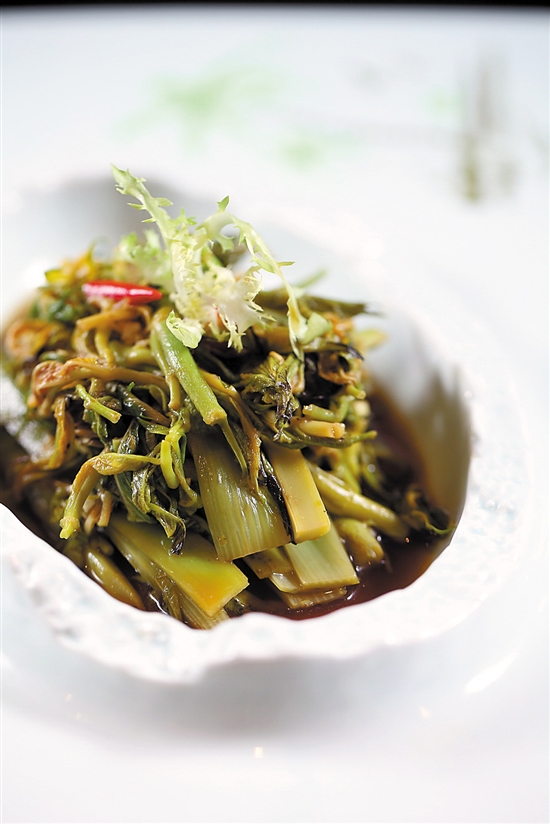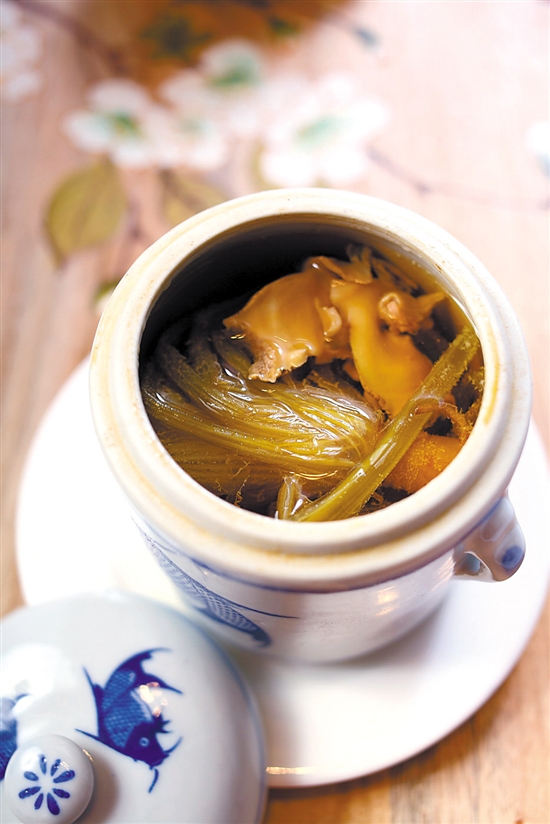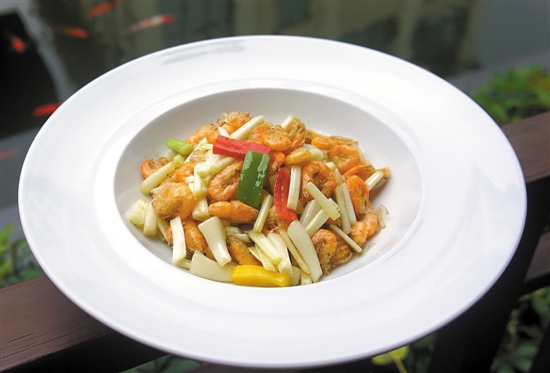Eating wild vegetables in spring makes up for the ancient style, and the spring is bright and fresh on the tip of your tongue.



Text/Figure Yangcheng Evening News reporter Wang Min
On the second day of the second lunar month, grass and vegetables are sprouting leaves, and the ancient Luoyang people designated this day as the Picking Vegetables Festival. Picking vegetables means going out to pick wild vegetables or picking vegetables in the garden. Eating wild vegetables in spring is not only a tonic, but also quite antique. At this time, you can see these seasonal wild vegetables in the markets and supermarkets in the city, but the bored urbanites in the city often like to go to suburban farms and mountains to find them themselves, that is, pick them and cook them and eat them fresh.
"Ginseng Roots" on the roadside of Ye Qiuqian
If you don’t look at the upper body, just look at the lower body, it can definitely imitate Laoshan ginseng, which is thick and scaly with dense fibrous roots. But the eyes moved up, and immediately the phoenix turned into a pheasant: Isn’t this a clam? Yes, it is coriander, but it is much rarer than ordinary coriander. It is only produced in Conghua, and the best is excavated in Liangkou area. This wild coriander is a mountain thing, born on the hillside, longer than the hillside, rough and rough, letting it absorb the essence of heaven and earth, rain and dew, and the sun and the moon.
Although it looks strong, it is actually a big man in the northeast with a soft heart in the south of the Yangtze River. The smell is not as strong as that of a common clam, and it is light and delicious, not to mention astringent, but smooth and fragrant. The practice in Conghua country is to use wild parsley with spicy roots to stew pork tripe. If the taste is lighter, chicken feet can be used instead of pork tripe. According to reports, drinking this soup in spring has the effect of eliminating dampness and warming the stomach.
It is most effective to stew soup with salted lemon. As long as there is a root in a cup of soup, it has been uncovered and moved to the next table. If you want to be fresher, you can also use it directly for cold salad. Its special flavor can often be tasted in some farmhouses in Conghua liang kou.
Thorn head vegetables are bitter and cool, but fragrant and refreshing.
Arrived in March, the wild vegetables in Shan Ye, Yunnan Province began to stir up. From the original sugar pear flower, broom, fish coriander and broken ear root to the present Toona sinensis, bracken, echinacea, plantain, cowpea and water celery … … When you go to Yunnan at this time, you will find these wild vegetables everywhere in the farmer’s market.
Among them, the most unfamiliar thing for Guangzhou people is the thorn vegetable. It is the bud of a thorn tree in the mountains. Because even the tender buds have thorns, it is called "thorny vegetable". Its leaf buds are very similar to Toona sinensis. Before the bud blooms, the leaf buds are wrapped in layers of leaves, ruddy and plump, shaped like new bamboo shoots and up to five or six inches long. When the leaves split, new leaves with tender thorns will be exposed.
Thorn head vegetables are the most common in Shangri-La, and the season is from April to July every year, among which April is the most tender and slag-free. Its growth cycle is very fast, and it can grow into the second crop in three days after picking the first crop of seedlings. However, you must pick it quickly, and you will meet the elders later, and then you will bite down and be full of slag. Locals like to eat it directly with garlic or coriander, which can keep the aroma to the maximum extent.
In addition to cold salad, it can also be dry mixed or stewed soup, but it must use plain oil, not meat, so as not to destroy its fragrance. When used in stews, it can only be served with chicken or lean meat.
In Guangzhou, it can only be found in Yunnan cuisine restaurant.
Stir-fried golden buckwheat vegetables add more fragrance.
In my memory, there are not many opportunities to eat spring buckwheat every year. About the time when the spring rains come down one after another, the family will buy a handful of spring buckwheat, carefully select it, cut it into sections, and simply fry it, and it will smell fragrant. In the listless spring, this is a refreshing dish that makes people’s forefinger move. It is clear but not scarce, tender but not raw, and it is the essence of home cooking.
Most of the buckwheat dishes seen on the market now are Hunan buckwheat. Although they are tender to eat, they always feel that the taste of the dishes is not enough. In fact, the really beautiful buckwheat dish is the local golden buckwheat in Guangzhou, which originated in Huadu and is called Huadu Silk Buckwheat. Unlike the Hunan version, this kind of buckwheat dish is not stout, with a thin head and a young body. Although it is petite, it tastes rich and fragrant.
However, whether it is silk buckwheat or foreign version of buckwheat, it is the most delicious near the head, and only the first and second stubble can be harvested, and then it will be old and tough, so it has to be used to make sour buckwheat heads.
Stir-fried buckwheat vegetables, the most feared thing is that the heat is not well grasped, and it is too cooked and has residue, and it is too raw and spicy. In order to make it better, the chef of "Peninsula Haoyuan" specially came up with a "three-stage frying" way to make it. Stir-fry the buckwheat with ginger wine first, then take it out after it changes color slightly; Then pat the garlic in wok and saute, then stir-fry the buckwheat with strong fire, splash Shao wine at the same time, then stir-fry quickly, add a little salt and sugar, and drain the oil; Finally, the shrimps in the river or the wok will be fried together, which will take no more than three minutes, in order to keep the crispy taste of buckwheat to the maximum extent.
Banlangen must be eaten to prevent colds.
Just as there must be detoxification grass where poisonous snakes haunt, there is Banlangen to prevent colds in the spring when influenza is most likely to wreak havoc. For many people, Radix Isatidis is an ironclad herb. When you go to a restaurant to eat this, it always feels a little off-flavor, especially the raw and dregs taste of wild vegetables, which is even more uncomfortable for Guangzhou people who are awkward.
If you want Banlangen to be slag-free, you have to choose Xishuangbanna. The stems and leaves of Radix Isatidis here are particularly green, so cool that they will ring when you bite at the entrance, even if you have cooked them with soup on the cloud legs, which is the favorite of the regular customers of "Xinguiyuan". The chef of "Gansimiduo yunnan art Restaurant" only selects tender leaves and sautes them with fire, retaining the original flavor of Radix Isatidis. The taste is bitter with some wild vegetables, but it is very heat-clearing and detoxicating.
Rapeseed heart is slender and has no muddy taste.
In the south of March, rape is a good time to pull out the core and blossom, so rape heart has become a very seasonal vegetable, which can’t be eaten in other seasons until it expires.
Rapeseed hearts moistened by rain, with flowers and bones, are tempting you. Even in Guangzhou markets, they are only four or five yuan each, which is not cheap, but definitely not expensive. Buy one or two, wash them, fry them or bake them, depending on your preference. Vegetable farmers should be careful when choosing rapeseed hearts, and don’t choose those that are too tall; The weather in the south is warm and humid now, and the cabbage is different every day, so don’t bloom.
The flowering Chinese cabbage in other places is sweet after frosting, and it will be slightly bitter in spring. However, the flowering Chinese cabbage is just in season in March, which is even later than the flowering Chinese cabbage. Compared with the local cabbage, the "starting rate" of rapeseed is very high, so you don’t have to waste too much when choosing vegetables. Its stalk is about 1/3 thinner than that of ordinary Chinese cabbage, with full flavor and moderate hardness.
When frying rapeseed hearts, you must wait until the wok emits white smoke before you can stir-fry them urgently. Then, the rapeseed heart is wok, and then the material head and lard are stir-fried, so that the rapeseed heart fried twice can be green, crispy and not soft and oily.